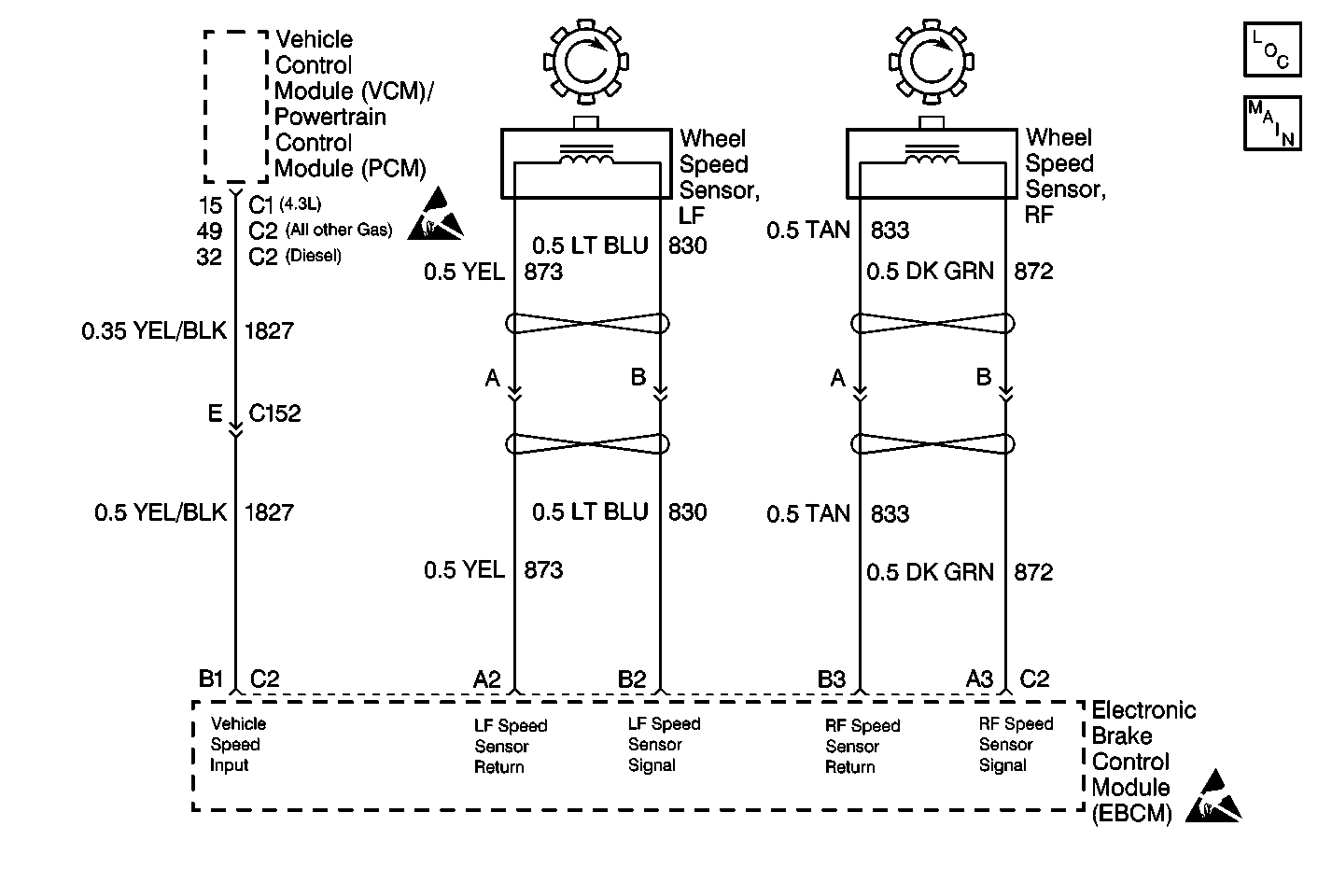
Circuit Description
The EBCM receives the rear wheel speed signal from the Vehicle Control Module (VCM) (4.3L Gas only), or Powertrain Control Module (PCM) (all other Gas). The rear wheel speed signal originates from the Vehicle Speed Sensor (VSS) which is connected to the VCM/PCM. When the vehicle is not moving, the VCM/PCM will have 12 VDC present on the circuit. The EBCM checks for this voltage when the vehicle is not moving.
Conditions for Setting the DTC
The wheel speed signal for all sensors is above 19 km/h (12 mph) with brake released, or 32 km/h (20 mph) with brake applied, with a sudden loss of one signal for 15 ms.
Action Taken When the DTC Sets
| • | The ABS indicator lamp turns on |
| • | The ABS disables |
DTC C0237 initially sets as a condition latched code. This means that the ABS system will be disabled and the ABS indicator lamp stays on as long as the condition exists. If the erratic DTC is set 3 consecutive times during the same ignition cycle, the DTC will set as an ignition latched DTC. This means that the ABS system will be disabled and the ABS indicator lamp stays on until the ignition is turned off; even if the fault goes away.
DTC C0237 is a DRP critical DTC, which means that DRP is disabled and the BRAKE indicator lamp will also light.
Conditions for Clearing the DTC
| • | Repair the conditions responsible for setting the DTC |
| • | Use the Scan Tool Clear DTCs function |
| • | Both a Condition Latched or Ignition Latched DTC may exist momentarily, or constantly. In either of the cases, the DTC will be stored in the EBCM memory until it is repaired, and/or the DTC is cleared. After the DTC is repaired and/or cleared and the ignition is turned to ON, the ABS lamp will remain lit until the EBCM completes a power-up self test. This test concludes when the vehicle has reached a speed of greater than 13 km/h (8 mph) and the wheel speed inputs have been checked by the EBCM. |
Diagnostic Aids
Correct any DTCs that are set in the VCM/PCM first.
This DTC can be set by a malfunction in the VSS, or a fault in CKT 821, 822 or 1827.
In addition, any of the following conditions may cause an intermittent malfunction:
| • | A poor connection |
| • | Wire insulation that is rubbed through |
| • | Wire breaks inside the insulation |
Thoroughly check any circuitry that is suspected of causing the intermittent complaint for the following conditions:
| • | Backed out terminals |
| • | Improper mating |
| • | Broken locks |
| • | Improperly formed or damaged terminals |
| • | Poor terminal to wiring connections |
| • | Physical damage to the wiring harness |
Test Description
The numbers below refer to the steps in the diagnostic table:
-
This step uses the voltage output from the PCM/VCM to check the 1827 CKT.
-
This step checks the 1827 CKT for proper resistance.
-
This step checks for a short in the wiring between the ECBM and the PCM/VCM.
Step | Action | Value(s) | Yes | No |
|---|---|---|---|---|
1 | Was the Diagnostic System Check performed? | -- | Go to Step 2 | |
Is the voltage measurement within the specified range? | Greater than 10 volts | Go to Step 4 | Go to Step 3 | |
Is the resistance measurement within the specified range? | 0-2ohms | Go to Step 5 | Go to Step 8 | |
4 |
Did the DTC set? | -- | Go to Step 6 | Go to Step 7 |
Using a J 39200 , measure the resistance from terminal B1 of the 16-way EBCM harness connector to ground by probing between terminals 9 and 7 in the J 39700. Is the resistance measurement within the specified range? | OL | Go to DTC P0500 Vehicle Speed Sensor (VSS) Circuit (4.3L), or DTC P0500 Vehicle Speed Sensor (VSS) Circuit (4.8L, 5.3L, 6.0L). | Go to Step 9 | |
6 | Replace the EBCM. Refer to Electronic Brake Control Module Replacement . Is the repair complete? | -- | -- | |
7 | Malfunction is intermittent. Inspect all connectors and harnesses for damage which may result in high resistance when all components are connected. Refer to Diagnostic Aids for more information. Perform all necessary repairs. Is the repair complete? | -- | -- | |
8 | Repair the open or high resistance in CKT 1827. Is the repair complete? | -- | -- | |
9 | Repair short to ground in CKT 1827. Is the repair complete? | -- | -- |
